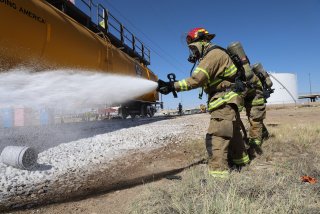Emergencies Policy Workgroup
Goal 4: Enhance Joint Preparedness for Environmental Response
The La Paz Agreement initiated a history of cooperation between Mexico and the United States, the objective of which is to preserve a “healthy environment for the long-term economic and social well-being of the present and future generations of each country, as well as the international community.” The La Paz Agreement establishes the general regulatory framework in which both countries agreed to prevent, reduce or eliminate sources of air, water and soil pollution. After its adoption, five cooperative agreements (Annexes) were established. Annex II of 1985 establishes cooperative measures to prepare for and respond to pollution from hazardous substances. It also defines the need for a Mexico-United States Joint Contingency Plan (JCP) that was developed in 1988 and signed in 1999. To date, the JCP has been updated and signed twice, first in 2008 and most recently in 2017. The JCP provided the basis for the Binational Joint Contingency Plans of the 15 Sister Cities situated along the border.
The Emergency Preparedness and Response Policy Workgroup, as well as the Joint Response Team (JRT) is co-chaired in Mexico by the Federal Attorney of Environmental Protection (PROFEPA) under SEMARNAT, and the National Civil Protection Coordination, of the Secretariat of Security and Citizen Protection (SSPC), and in the United States by the U.S. EPA Office Emergency Management (OEM). Additional JRT partners include representatives from other U.S. and Mexican federal agencies, including state, tribal and local offices responsible for emergency prevention, preparedness, and response in the border region.
Note: To see the full details of each goal refer to the framework.
Objective 1: Update the Joint Mexico-United States Contingency Plan (JCP) and evaluate the emergency notification system along the border of Mexico and the United States.
Objective 2: Review, update and evaluate the Sister City Joint Contingency Plans (SCJCPs).
Objective 3: Strengthen the training of emergency response personnel through the development of in-person or online training courses by creating a certificate of skills recognized by corresponding authorities. Additionally, develop and disseminate technical support material to help inform the public in case of emergency.
Objective 4: Design and implement the guidelines and protocols to ensure rapid, safe, and legal passage of personnel and materials across the Mexico – United States border in emergency response situations.
Goal 4 StoryMap

The Story Map serves as a visual representation of the joint efforts between countries to prepare for and respond to hazardous environmental emergencies. Hazardous incidents can extend beyond the political boundary between the U.S. and Mexico, potentially impacting citizens living along the border. The Story Map includes interactive features that visualize hazardous incidents, population densities, previous responses, and details on cross-border training and exercises. Users can visualize how population centers are correlated with higher risks of hazardous incidents through the spill report map, which automatically updates using information from the National Response Center. Visitors can learn about how the binational emergency response teams train and exercise to build their capacity to respond to complex environmental emergencies that may occur within the 100-km border region. The Story Map also provides excellent examples of the Binational Plan being utilized to respond to incidents and protect the health of both Mexican and American citizens who reside in this region.
Additional Resources:
- United States -Mexico Joint Contingency Plan (2017 - English)
- United States - Mexico Joint Contingency Plan (2017 - Spanish)
- Sister City Plans
- EPA Emergency Response
